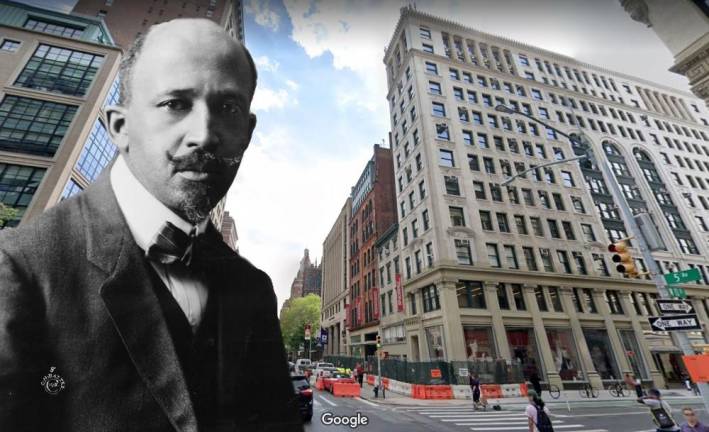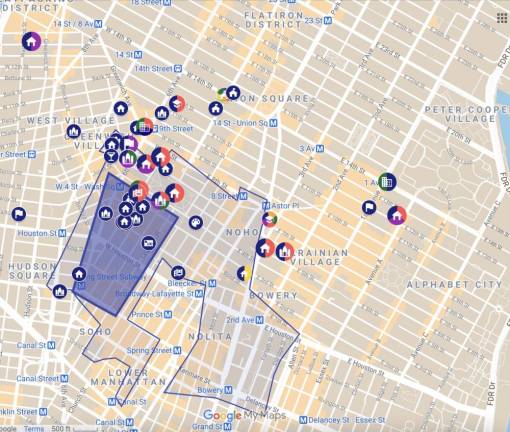For Black History Month, we as a country look back and celebrate the historic achievements of our Black forebears while paying homage to their brothers and sisters who continue to change the future. How can we adequately celebrate Black history in this country, specifically right in our neighborhoods, if their culture isn’t being properly being preserved and celebrated — right among us — in these very blocks?
Andrew Berman, executive director at the Greenwich Village Society for Historical Preservation, spoke with Our Town about the work that the GVSHP is doing to get protected status on sites of historic and cultural significance for marginalized communities — such as women, LGBTQ people and the Black community.
“I think at any time it’s important to make sure those stories are remembered, retold, preserved, and their significance elevated,” said Berman. “But I think it’s especially important now because we are having such a national reckoning around these issues. It’s really important that we recognize the struggles of the past, the battles that were fought, who waged them, who fought against them, what was accomplished, because we’re never going to make for a better future if we don’t understand our past.”
One of the stories Berman and the GVSHP are working hard to tell is that of the country’s first freed Black settlement which was actually right here in our neighborhoods in the early 1600s. Berman says it was located in what is now Greenwich Village, the East Village, parts of the Lower East Side, SoHo and NoHo.
“These were all formerly enslaved people, under Dutch rule, who managed to secure their freedom and were given land grants for the area north of what was then New Amsterdam, which ended at Wall Street. Land that they could farm. There were a lot of restrictions on them,” Berman said. “Some would argue that this was a selfish gift on the part of the Dutch because they wanted a buffer between their settlements to the south and the Native Americans to the north with whom there was often conflict. But, nevertheless, these were the first people, other than the Native Americans, who lived in our neighborhoods.”
There’s not much left of these “first villagers.” Except for the work of the GVSHP and other historical preservationists, they are otherwise wiped clean from history. “For a lot of people, it’s not the story we wanted to tell,” said Berman. “We, in too many cases, haven’t wanted to think about the plight of African Americans and the injustices done to them. We also haven’t wanted to think of them as sort of the first or the best or the earliest because in too many cases we have an image of who that should be and it’s not necessarily an African American.”
Berman also said that a lot of the information about these people was not available at the time those stories were being kept, so it was easy for them to fade away.
NAACP’s Early Campaigns
In addition to the work the GVSHP has done to bring light the city’s freed Black history, it is also working to preserve many more modern sites and buildings, such as 70 Fifth Avenue.
This Beaux-Arts building was the home to many organizations that have shaped our history, one of the most prominent of which was the National Association for the Advancement of Colored People. Not long after it was founded in 1909, the NAACP moved its headquarters to 70 Fifth Avenue and stayed there well into the 1920s.
“In a lot of ways, it’s a perfect example because I don’t think you can get a site that’s more clearly worthy of preservation ... of being deemed something like a landmark — which means it’s an important part of our collective history — than 70 Fifth Avenue,” said Berman. “This is the place where the NAACP led a lot of their first and earliest campaigns against lynching and other kinds of racial violence, where they began the process of litigation for rights of African Americans — which eventually led to Brown v. Board of Education decades later and the desegregation of our schools and our society — where they first began campaigns against blatant discrimination against African Americans in employment, in housing and in voting rights, as well as defamatory representations in the media...”
An offshoot of the NAACP spearheaded by W.E.B. Du Bois, The Crisis, was a magazine that was published from 70 Fifth Avenue and served as the voice of African American life as well as to promote civil rights and other initiatives of equality.
Berman says this was emblematic of the area at this time in terms of how politics and culture often came together, and that the NAACP and The Crisis are “just the tip of the iceberg” in terms of the groups that got their start at 70 Fifth Avenue. Some of the others included the American Civil Liberties Union, what was then known as the American Committee for Relief in the Near East (now known as the Near East Foundation), the American Federation of Teachers and countless others.
Preservation Status
More than two years ago the GVSHP set the wheels in motion for 70 Fifth Avenue to receive some sort of preservation status — if not full-blown landmark recognition. Berman believes that the city’s Landmark Preservation Committee has been slow with their progress.
In lieu of an interview, the Landmark Preservation Committee’s director of communications Zodet Negrón sent this statement on behalf of the Committee:
“LPC is committed to ensuring diversity and inclusion in our designations. As part of our equity framework, we are prioritizing designations like 70 Fifth Avenue, to make sure that we are telling the stories of all New Yorkers. 70 Fifth Avenue is significant for housing the national office of the National Association for the Advancement of Colored People (NAACP) among a remarkable tenant roster of progressive organizations that have shaped American society.”
70 Fifth Avenue was calendared on Jan. 19, which is an early step in the Committee’s process of assessing sites. The LPC will hold a public hearing on the proposed designation “at a future date,” as Negrón’s email read, after which the Committee will meet and vote on the designation.
“70 Fifth Avenue it’s been a struggle. It’s been two and a half years that we’ve been trying to get the city to move on this,” Berman said. “They finally have, but it’s really one of scores of sites in this neighborhood south of Union Square that have this kind of extraordinary history connected to various civil rights struggles, African American, women, LGBTQ, et cetera.”
While getting 70 Fifth Avenue on the LPC’s calendar is a step in the right direction, that is just one building — with myriad stories. The city is full of them. Berman seems resolved on preserving as many of them as he can.
“We want people to be able to stand in front of 70 Fifth Avenue and know that this is where the first anti-lynching legislation was created,” said Berman. “We want them to be able to stand across the street from at 55 Fifth Avenue and say this is where Billie Holiday made her first recordings where many of the first integrated recordings were made when Black and white people recording music together was an un-chattered taboo. Our hope is that these sites will be preserved and protected and given the respect that they’re due. Which so far, the city has not done.”
“It’s really important that we recognize the struggles of the past, the battles that were fought, who waged them, who fought against them, what was accomplished, because we’re never going to make for a better future if we don’t understand our past.” Andrew Berman, GVSHP

